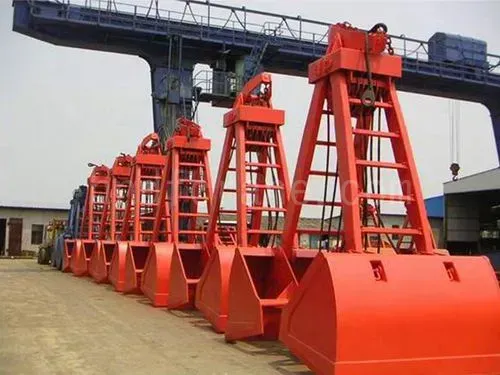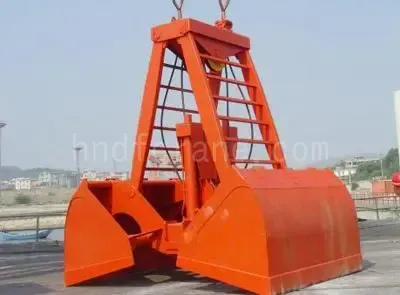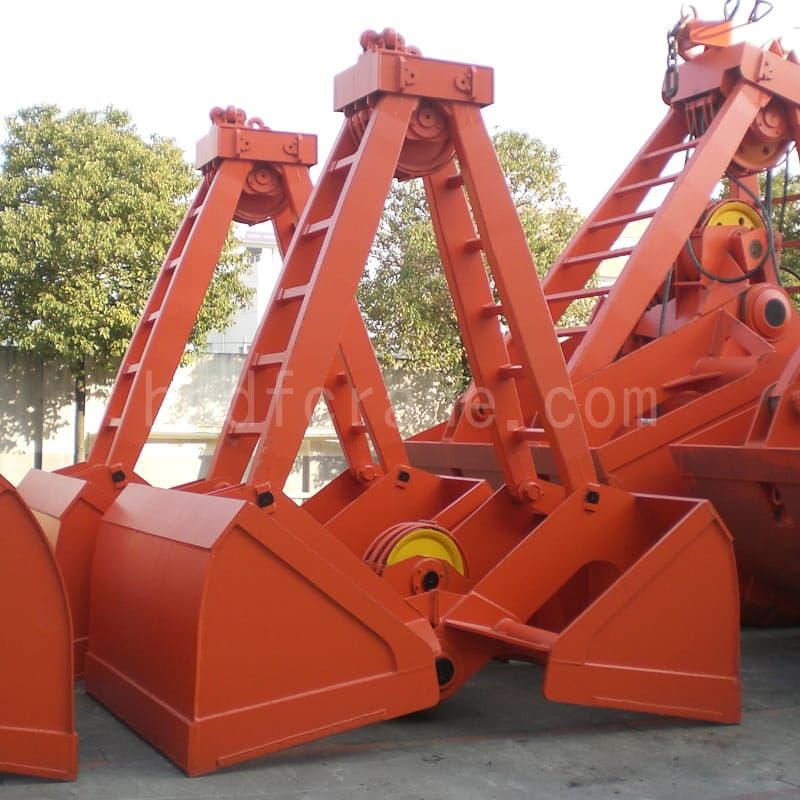Présentation du produit : benne preneuse mécanique à deux câbles
La benne preneuse mécanique à deux câbles convient à tous les types de grues avec structure de dispositif de levage double et est principalement utilisée dans les ports, les quais, les routes et ponts de construction et d'autres industries.
Selon les caractéristiques du matériau, il peut être équipé de charges légères, moyennes, lourdes et super lourdes. Convient pour saisir toutes sortes d'accumulations en vrac.
Ensuite, plusieurs grues. Equipées de deux jeux de bobines motorisées (c'est-à-dire de palans électriques), chaque jeu de bobines conduit à un câble métallique dont l'un sert de support sur le cadre d'équilibrage de la pince, et l'autre câble métallique passe dans les poulies des poutres supérieure et inférieure pour former un bloc poulie, qui joue un rôle dans l'ouverture.
Les bennes preneuses mécaniques à deux câbles sont un outil efficace pour le chargement et le déchargement de marchandises en vrac telles que du sable jaune, du charbon, de la poudre de minerai et des engrais en vrac dans divers environnements difficiles.
Les bennes preneuses mécaniques à deux câbles ont une structure simple, un nouveau mécanisme d'ouverture et de fermeture, sont faciles à utiliser et peuvent effectuer avec précision les actions d'ouverture et de fermeture dans divers états.
Les bennes preneuses mécaniques à deux câbles adoptent une conception virtuelle tridimensionnelle et le logiciel ANSYS est utilisé pour l'analyse et la vérification de la résistance. La répartition du poids est plus raisonnable et la durée de vie est plus longue.
La poutre porteuse supérieure des bennes preneuses mécaniques à deux câbles est équipée de cosses qui peuvent être directement connectées à la manille du câble de levage de la grue.
Paramètres techniques des bennes mécaniques à deux câbles

| Type et taille | Volume(m3) | Poids mort) | Dimensions (mm) | Diamètre de la poulie(mm) | Utiliser la hauteur(m) | Câble en acier de diamètre(mm) | SWL(t) | ||||
| UN | B | C | D | E | |||||||
| BS3[1.2]1.3A | 1.2(300) | 1.4(4) | 1900 | 2537 | 2488 | 2841 | 1200 | ø400 | 9 | ø17,5 | 3 |
| BS3[1.6]1.4A | 1.6(300) | 1.4(4) | 2100 | 2631 | 2559 | 3040 | 1300 | ø400 | 9.5 | ø17,5 | 3 |
| BS5[1.5]2A | 1.5(350) | 2(3) | 2000 | 2659 | 2667 | 3075 | 1260 | ø445 | 8.5 | ø19,5 | 5 |
| 2(4) | 9.8 | ||||||||||
| BS5[2]2A | 2(350) | 2(4) | 2100 | 2778 | 2818 | 3248 | 1400 | ø445 | 10 | ø19,5 | 5 |
| BS5[2.5]2A | 2.5(350) | 2(3) | 2100 | 2787 | 2715 | 3091 | 1600 | ø445 | 8.5 | ø19,5 | 5 |
| BS5[3]2A | 3(400) | 2(3) | 2300 | 3130 | 2938 | 3362 | 1650 | ø445 | 9 | ø19,5 | 5 |
| BS8[2.6]3.2A | 2.6(300) | 2.6(4) | 2300 | 3038 | 3257 | 3736 | 1800 | ø560 | 11 | ø26 | 8 |
| BS8[3]3.3A | 3(300) | 3.3(4) | 2380 | 3118 | 3287 | 3786 | 1900 | ø560 | 11.5 | ø26 | 8 |
| BS8[3.8]3.5A | 3.8(300) | 3.5(4) | 2550 | 3536 | 3286 | 3733 | 2000 | ø560 | 12 | ø26 | 8 |
| BS8[4.5]3.8A | 4.5(300) | 3.8(3) | 2500 | 3505 | 3503 | 3975 | 2300 | ø560 | 12 | ø26 | 8 |
| BS10[3]4A | 3(300) | 4(4) | 2380 | 3118 | 3287 | 3786 | 1900 | ø560 | 11.5 | ø28 | 10 |
| BS10[5]4A | 5(350) | 4(4) | 2615 | 3605 | 3503 | 3975 | 2400 | ø560 | 12 | ø28 | 10 |
| BS10[6]4A | 6(400) | 4(4) | 2800 | 3814 | 3758 | 4290 | 2150 | ø560 | 12.5 | ø28 | 10 |
| BS16[3.6]6A | 3.6(300) | 6(5) | 2500 | 3313 | 3810 | 4206 | 2100 | ø720 | 13.5 | ø32 | 16 |
| BS16[4]6A | 4(350) | 6(5) | 2500 | 3313 | 3810 | 4206 | 2200 | ø720 | 13.5 | ø32 | 16 |
| BS16[6]6A | 6(350) | 6(4) | 2900 | 3800 | 4249 | 4612 | 2400 | ø720 | 13.5 | ø32 | 16 |
| BS16[10]6A | 10(400) | 6 (3) | 3200 | 4000 | 3938 | 4673 | 2500 | ø650 | 12 | ø28 | 16 |
Comment choisir le bon grappin
- Clarifiez votre objectif :
Avant d'examiner les options, veuillez clarifier vos besoins spécifiques. Posez-vous les questions suivantes :
- Quels matériaux souhaitez-vous traiter ? (Bûches, ferraille, pierre, etc.)
- Quelles tâches la benne effectuera-t-elle ? (chargement, tri, démontage, etc.)
- À quel type d'appareil sera-t-il connecté ? (grue à portique, pont roulant)
- Quelle est la gravité spécifique du matériau que vous saisissez ? Le nombre de cubes de la prise ?
Quel est le tonnage de votre grue équipée d'une benne preneuse ?
Selon les caractéristiques du matériau à saisir, la benne est généralement divisée en quatre types de base : légère, moyenne, lourde et super lourde.
| Le type de matériel à saisir | Saisir le matériel | Capacité pondérale (t/m³) |
| Lumière | Coke, scories, céréales, pommes de terre, chaux anthracite de qualité moyenne, ciment, terre, gravier, argile, briques cassées, etc. | 0.5~1.2 |
| Moyen | Tourbe, gros morceaux de charbon anthracite, charbon compacté, argile, calcaire, gravier, sel, gravier, briques, bauxite, paillettes d'oxyde de fer, ciment, sable et briques dans l'eau, etc. | 1.2~2.0 |
| Lourd | Calcaire, argile lourde, minerais de petite et moyenne taille, roche dure, oxyde de fer en forme de tige, minerai de fer, poudre de concentré de plomb, etc. | 2.0~2.6 |
| Embonpoint | Gros minerais, gros minerais de manganèse, poudre de minerai de plomb agglomérée sédimentaire, etc. | 2.6~3.3 |
- Compatibilité des accessoires : Assurez-vous que la benne est compatible avec l’équipement existant.
- Considérations budgétaires : La gamme de prix du grappin est différente. Équilibrez votre budget en fonction de la fonction et de la durabilité du grappin.
- Commentaires et suggestions : Effectuez des recherches en ligne, lisez les avis des utilisateurs et sollicitez les suggestions de vos pairs du secteur.
- Rendez-vous chez le fabricant de la grue pour une inspection et des tests sur site avant l'achat : Testez le grappin dans des conditions réelles autant que possible. Évaluez ses performances, sa facilité d'utilisation et sa fonctionnalité globale.
Gardez à l'esprit que le choix du bon grappin nécessite un équilibre entre fonctionnalité, sécurité et coût. En prenant en compte ces fac





















































































